Holding a duck may seem like a simple task, but it can be quite challenging, especially for those who are new to handling them. Ducks are delicate creatures that require proper handling to avoid injuring them or causing them stress.
Holding a duck correctly involves supporting its body and not squeezing it. Approach the duck calmly, slowly cup your hands around its body, and gently lift it. One hand should support the chest and the other should secure the wings. Always handle ducks gently, as they can become stressed if restrained too tightly.
Key Takeaways
Regularly picking up and handling ducks, whether they’re pets or backyard ducks, is essential for their well-being. It allows for health checks, fosters familiarity, and can be crucial in times of injury or illness.
Not all ducks are the same. Handling may vary based on their species, breeds, and sizes. For instance, Muscovy ducks, with their sharp claws, may require different handling techniques compared to other breeds.
Picking up or handling wild ducks is generally not advised unless it is medically essential due to the risk of spreading diseases and potential harm to the ducks.
When picking up a duck, one must remember to support their feet, offer treats, nestle them against the body, avoid sudden movements, and remain calm. Do it by: support, Offer treats, nestle, avoid sudden movements, and Remain calm.
When setting down a duck, it should be done gently to avoid any injuries.
Catching a duck can be done by herding them into a fenced corner area and firmly but gently grabbing them.
Key dos and don’ts when it comes to handling ducks
Dos
- Do Approach Calmly: Approach ducks slowly and gently to avoid startling them. Make sure your movements are predictable and non-threatening.
- Do Support Them Properly: When picking up a duck, use both hands. One should be placed under the chest to support the duck’s body, while the other should gently secure the wings against the body.
- Do Handle with Care: Ducks are delicate creatures and can get hurt easily. Make sure to handle them with care to prevent any injuries.
- Do Offer Treats: Offering treats can help to gain a duck’s trust and make them more comfortable around you.
- Do Regular Health Checks: Regular handling allows for health checks, familiarity, and can be crucial in times of injury or illness.
Don’ts
- Don’t Rush: Never rush when approaching a duck. This can scare them and make them stressed.
- Don’t Squeeze: Never squeeze a duck’s body too tightly. This can cause them discomfort or injury.
- Don’t Hold by the Neck or Legs: Never lift a duck by the neck or legs, as this can cause serious harm.
- Don’t Startle Them: Avoid loud noises or sudden movements that could startle the duck.
- Don’t Handle Unnecessarily: Avoid handling ducks without a reason as it can stress them out. Touch them only when it is required for their health, safety, or well-being.
Remember, proper handling when raising ducks is crucial for their physical health and psychological well-being. Always strive to create a calm, safe environment for them.
Approaching a Duck
Ducks are generally friendly and approachable birds, but they can become skittish if they feel threatened or scared. Here are some tips on how to approach a duck safely and calmly:
Catching a Duck
If you need to catch a duck, it’s important to do so gently and without causing any harm or stress to the bird. One effective method is to use a herding stick to guide the duck into a corner or enclosed area. Once the duck is in a confined space, you can move slowly and carefully towards it, making sure to avoid sudden movements or loud noises.
When you’re close enough to the duck, you can reach out and grab it gently but firmly with both hands, making sure to support its body and wings. If the duck struggles or tries to escape, try to remain calm and hold it steady until it calms down.

Handling Skittish Ducks
Some ducks may be more skittish or nervous than others, especially if they are not used to being handled or are in an unfamiliar environment. If you need to handle a skittish duck, there are a few things you can do to help calm it down:
Move slowly and calmly, avoiding sudden movements or loud noises
Speak softly and reassuringly to the duck, using a soothing tone of voice
Offer the duck some food or treats to help it relax and feel more comfortable
If the duck is still too nervous or agitated to be handled safely, it may be best to wait until it calms down or seek the assistance of a professional.
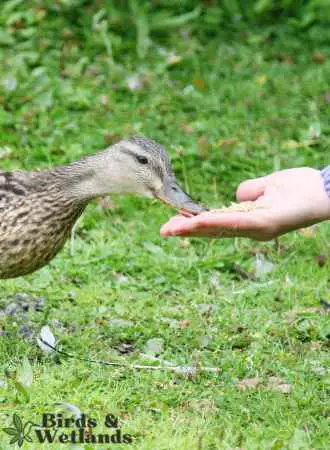
Proper Technique for Holding a Duck
Holding a duck can be a bit tricky, especially if you are new to handling them. It is important to handle ducks carefully to avoid injuring them or causing them undue stress. Here are some tips on the proper technique for holding a duck.
Gripping the Duck
The first step in holding a duck is to grip it properly. You should use both hands to grip the duck firmly but gently. Place one hand under the duck’s body and the other hand over the duck’s back. Make sure to keep your fingers away from the duck’s head and neck, as this can cause them discomfort.
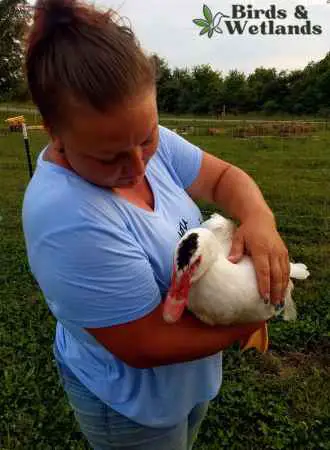
Supporting the Duck
Once you have a good grip on the duck, it is important to provide proper support. Ducks are delicate creatures and can easily be injured if not handled carefully. Make sure to support the duck’s body weight with your hands and arms. You can also use your body to help support the duck, by holding it close to your chest.
When carrying a duck, it is important to keep it level and avoid jostling it around. This can cause the duck to become stressed and can also lead to injuries. If you need to set the duck down, make sure to do so gently and avoid dropping it.

Parts of a Duck to be Mindful of
When handling a duck, it is important to be mindful of its anatomy to ensure that you do not accidentally hurt the bird. Here are the parts of a duck that you should be aware of:
Feet and Legs
A duck’s feet and legs are important for its mobility and balance. When holding a duck, be sure to support its feet and legs securely to avoid causing any discomfort or injury. You can use your hand to grasp the duck’s legs, making sure that your grip is not too tight.
Wings
Ducks’ wings are used for flying and swimming. When holding a duck, it is important to be mindful of its wings to avoid causing any damage. You can gently hold a duck’s wings against its body, making sure that they are not bent or twisted.
Neck and Chest
A duck’s neck and chest are delicate areas that should be handled with care. When holding a duck, be sure to avoid putting too much pressure on these areas. You can use your hand to gently support the duck’s chest, making sure that its neck is not twisted or strained.
Vent Area
The vent area is where a duck’s reproductive and digestive organs are located. When holding a duck, it is important to be mindful of this area to avoid causing any discomfort or injury. You can avoid touching this area altogether or use a towel to cover it while holding the duck.
Different Breeds of Ducks and their Handling
When it comes to handling ducks, it’s important to consider the breed and their unique characteristics. Here are some tips for handling different breeds of ducks:
Domesticated Duck Breeds
Domesticated ducks come in various breeds, each with its own personality and temperament. Some breeds are calmer and easier to handle than others. For example, Welsh Harlequin ducks are known to be calm and friendly, while Runner ducks can be skittish and difficult to handle.
When handling domesticated ducks, it’s important to approach them calmly and slowly. Offer them food as a way to gain their trust and make them more comfortable with human interaction. Use both hands to support the duck’s body when picking them up, making sure to avoid squeezing them too tightly.

Wild Ducks
Wild ducks are generally more difficult to handle than domesticated ducks. They are not used to human interaction and can become easily stressed or frightened. It’s important to avoid handling wild ducks unless it’s absolutely necessary, such as when rescuing injured ducks.
When handling wild ducks, it’s important to wear gloves and protective clothing to avoid injury. Use a net to capture the duck and place it in a secure container for transport.
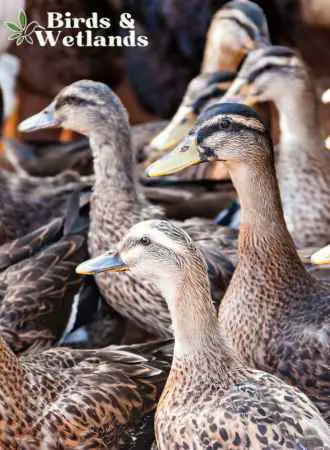
Baby Ducks
Baby ducks, or ducklings, are fragile and require special handling. When picking up a duckling, use both hands to support its body and avoid squeezing too tightly. Ducklings should be kept warm and dry, and should never be left unattended near water.

Breeds of Ducks
Understanding the different characteristics of duck breeds is crucial when it comes to handling them. The variety in size, temperament, and physical features amongst duck breeds influences how they should be approached and managed.
Take, for example, the Call duck. This breed is small, making them relatively easy to handle, especially for beginners or children. They are known for their docile and friendly nature, which often makes them comfortable around people. However, their small size necessitates a gentle touch. The smaller the duck, the more delicate they can be, so extra care must be taken when handling them to avoid causing harm.
On the other end of the spectrum, we have breeds like the Pekin duck. These ducks are large, often weighing up to 11 pounds. Due to their larger size, Pekin ducks require more robust handling. When lifting a Pekin duck, one must ensure to adequately support their bulk to prevent any injuries. Pekins, despite their size, are generally friendly and calm, making them easier to handle despite their weight.
In contrast, the Muscovy duck is an independent breed and can be more challenging to handle due to their large claws and less social nature.
The Runner duck, an unusually upright breed, can be skittish and may require extra patience and calm when handling.
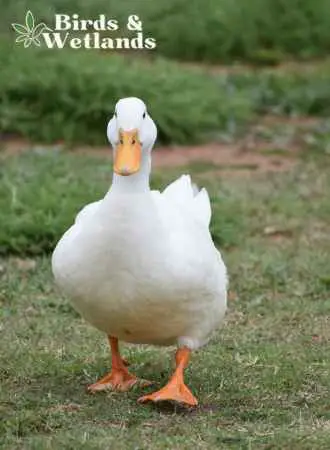
Tools and Equipment for Handling Ducks
When it comes to handling ducks, having the right tools and equipment can make the process easier and safer for both you and the duck. Here are some essential items to consider:
Decoys
Decoys can be a useful tool for catching ducks. They work by attracting ducks to a specific area, making it easier to catch them. Decoys come in various shapes and sizes, and you can choose from a range of materials, including plastic, foam, and wood. Some decoys are designed to float on water, while others are made to be placed on land.
Fishing Net
A fishing net is a versatile tool for catching ducks. It can be used to scoop ducks out of the water or to catch them on land. Fishing nets come in various sizes and materials, so it’s important to choose one that is appropriate for the size of the ducks you are handling.
Scoop
A scoop is a small net attached to a long handle. It’s a useful tool for catching ducks in confined spaces, such as a coop or a small pen. Scoops come in various sizes, so it’s important to choose one that is appropriate for the size of the ducks you are handling.
Animal Carrier
An animal carrier is a safe and secure way to transport ducks. It can be used to move ducks from one location to another, such as from a coop to a pond. Animal carriers come in various sizes, and some are designed specifically for ducks.
Blind
A blind is a useful tool for catching ducks in the wild. It’s a camouflaged shelter that you can use to hide from ducks and get closer to them without being seen. Blinds come in various sizes and materials, so it’s important to choose one that is appropriate for the size of the ducks you are handling.
Stick
A stick can be a useful tool for herding ducks into a specific area. It can also be used to gently guide ducks in the direction you want them to go. When using a stick, it’s important to be gentle and not to apply too much pressure to the ducks.
Handling Injured Ducks
When handling an injured duck, it is important to take extra care to avoid causing further harm. Here are some tips on how to handle injured ducks safely and effectively.
Preventing injuries is the first step in ensuring the well-being of ducks. Here are some things you can do to prevent injuries from occurring:
Keep the environment safe and free of hazards, such as sharp objects or slippery surfaces.
Provide adequate space for the ducks to move around and exercise.
Avoid overcrowding, as this can lead to stress and injuries.
Provide proper nutrition and clean water to keep the ducks healthy.
If you notice that a duck is injured, it is important to take action as soon as possible. Here are some steps you can take to treat injuries:
Assess
Before you approach the duck, observe its behavior and try to identify the location and severity of the injury.
Approach
Ducks may be frightened or in pain, so approach slowly and calmly to avoid causing further stress.
Secure
Gently but firmly hold the duck by the wings and body to prevent it from moving or flapping its wings.
Treat
Depending on the type of injury, treatment may involve cleaning the wound, applying medication, or providing supportive care such as warmth and rest.
Monitor
After treating the injury, monitor the duck closely for any signs of infection or worsening symptoms. If necessary, seek veterinary care.
Remember, handling injured ducks requires patience, care, and attention to detail. By taking the proper precautions and following these steps, you can help ensure the well-being of injured ducks in your care.
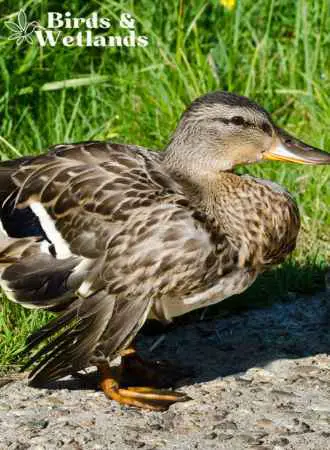
FAQs on How to Hold Ducks
How do you get a duck to come to you?
Building trust with a duck requires patience and consistency. Frequently interacting with them, using a calm voice, and offering food treats can help. However, remember that ducks are prey animals and may require time to feel secure around humans.
Will ducks let you pick them up?
Many ducks will tolerate being picked up if they are accustomed to human contact from a young age. Regularly picking them up can make them more comfortable, but remember to always use appropriate technique and handle them gently to avoid injury.
Can you hold a pet duck?
Yes, you can hold a pet duck, but it requires understanding and practicing the right technique. Place both hands securely on the duck, one to support the duck’s body and the other to secure the wings. Larger ducks may need extra support.
Is it safe to hold a duck?
Holding a duck is safe as long as the correct technique is used. It is an unacceptable practice to grab them by their necks or legs as this can gravely injure ducks. It’s advisable to have hands-on training from a veterinarian or care expert on proper handling techniques and always watch for potential hazards like their claws!

